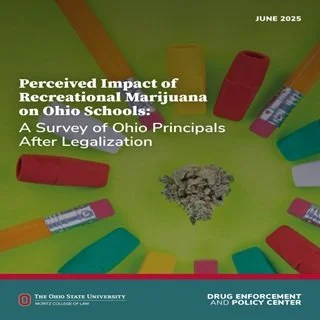By Maria M. Orsini, Peter Leasure, & Jana Hrdinova
After Ohio voted to legalize recreational marijuana in November 2023, and before recreational marijuana became available for sale in Ohio in August 2024, the Drug Enforcement and Policy Center surveyed Ohio’s K-12 school principals to inquire about how they anticipated marijuana legalization would impact their schools and their students. In spring 2025, the center again surveyed Ohio’s principals to explore their perceptions of how marijuana legalization has impacted their schools and students now that recreational marijuana sales have commenced. This second survey, which used a nearly identical online survey instrument, was distributed to principals to allow for a comparison of anticipated impacts prior to the beginning of marijuana sales and actual experiences after marijuana sales started. Overall, results from the 2025 survey aligned fairly closely with principals’ anticipated concerns in 2024, with a few areas seeing a lower level of experienced impact such as on dropout rates, students’ behavior at school, and overall school safety. While these results suggest that principals overall anticipated a worse impact of marijuana legalization prior to the beginning of recreational sales than what they experienced after sales commenced, this conclusion has two important caveats. First, while the perceived impacts on students are lower in a few areas than the anticipated impacts from 2024, this result does not mitigate the fact that at the high school and middle school levels, principals in 2025 reported concerning observations with respect to the increased use of marijuana among their students, students’ academic performance, health, and impact on school safety, among other things. Second, our survey recorded responses from a relatively small number of Ohio’s principals and only asked about their perceptions, which does not allow us to draw any definitive conclusions about the actual effects of marijuana legalization. If state legislators and voters want to explore the concrete impact of marijuana legalization on students, it is crucial to collect and study actual student data on metrics related to academic performance, behavioral issues, mental and physical health, marijuana and other drug use, and school completion.
Ohio State Legal Studies Research Paper No. 928,





